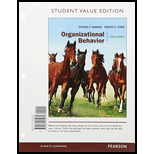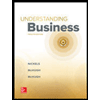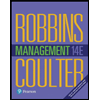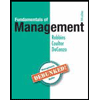
To determine:
The different types of groups that may be formed
Introduction:
A group is generally identified as the gathering or collection of two or more individuals who proceed to interact and are inter-reliant on each other to work towards the accomplishment of specific objectives.
Explanation of Solution
There are two types of groups that may be formed, namely, formal groups and informal groups. In particular, formal groups are the ones that are created by the organization and defined by its structure, with designated job assignments and fixed tasks allocated to the group members. Further, the behavior and actions involved in by the members of a formal group are specified by and pointed towards the achievement of the company’s goals.
Contrastingly, informal groups are the ones that are formed quite spontaneously through similar interests and friendships developed among two or more members of an organization. To clarify, they are formed with no direction from the management of the organization and are not formally structured. Nevertheless, informal groups satisfy the necessity for social interaction among its members, and thus profoundly affect their performance and behavior.
Want to see more full solutions like this?
Chapter 9 Solutions
Organizational Behavior, Student Value Edition Plus MyLab Management with Pearson eText -- Access Card Package (17th Edition)
- Can you guys help me on this? Thank you! Here's the authentic insight my classmate wrote about the article they chose here. Please give a little comment on this insight that my classmate just wrote. Thank you!arrow_forwardIdentify potential ethical challenges in producing and marketing your company's skincareproducts in europe and associated countries like germany italy and france and how your team will address them.arrow_forwardDiscuss knowledge and skills international managers need to navigate the expansion of skincare line in international markets such europe including countries like germany italy and francearrow_forward
- Research Methods for Business Research Topic : Improving Customer Retention in the Hotel Industry Through Personalized Marketing Strategies. 1. Based on the research topic please provide an introduction for a research report. Please use the screenshot for guidance on how to do the introduction. please add citations and references.arrow_forwardDiscuss knowledge and skills international managers need to navigate the expansion ofskincare line in international markets such as europe including countries like germany italy and francearrow_forwardYou have reviewed probability rules and the types of probability distributions in this chapter. For this discussion board assignment: Describe ways you are applying (or can apply) probability distributions in your workplace. Choose a discrete probability distribution and a continuous probability distribution, and describe how they can assist you in your profession. If you are not currently working, describe how they can assist in your targeted profession. How can the tools learned in this chapter help you make better decisions at work?arrow_forward
- | do not copy from another same ques answer,i need differe nt one. Task Description: One of the most important questions faced by business leaders in the strategic marketing process is a choice of timing to launch new product/technologies and enter new markets. There are two options: to be a pioneer or to be a follower. Both have advantages and risks, the relative success of each strategy depends on several factors, both internal and external. Tasks: Answer the following essay questions: 1. What are the advantages of being a pioneer and follower company? Provide examples of successful pioneer and follower companies. 2. What product life cycle strategies do successful pioneer and follower companies implement to increase growth and maintain a strong competitive advantage? Provide examples of companies to support statements made. Follow instruction: 1. Word: within 2500 word, not bellow 2400. 2. Give table, charts, diagrams, graphs and images should be properly cited and properly named.arrow_forwardHow can viewing a new restaurant organization at the three levels of quality, including the "strategic level" (Senior leadership), "tactical level" (middle management), and "operational level" (Frontline emoyees), enhance the business plan?arrow_forwardThis week we looked at descriptive statistics and the role they play in helping us understand the data we have. For this discussion board assignment, imagine that you are helping your friend in buying a home in the greater St. Louis region. How would you use the methods learned in this chapter to inform you and your friend? Choose any 2 measures of location, 2 measures of dispersion and 2 measures of association and explain how you would use them to aid your home hunting process.arrow_forward
- What is the purpose of primary and secondary data in researcharrow_forwardHow does the research fulfill the requirement and integrate a Christian worldview? What are the research concepts of Potential Research Locations and biblical perspective? What is the Potential Research Location and where the qualitative single case study could be conducted?arrow_forwardPlease anwer question Develop a high-level or summary: Human Resource Management Planarrow_forward
 Understanding BusinessManagementISBN:9781259929434Author:William NickelsPublisher:McGraw-Hill Education
Understanding BusinessManagementISBN:9781259929434Author:William NickelsPublisher:McGraw-Hill Education Management (14th Edition)ManagementISBN:9780134527604Author:Stephen P. Robbins, Mary A. CoulterPublisher:PEARSON
Management (14th Edition)ManagementISBN:9780134527604Author:Stephen P. Robbins, Mary A. CoulterPublisher:PEARSON Spreadsheet Modeling & Decision Analysis: A Pract...ManagementISBN:9781305947412Author:Cliff RagsdalePublisher:Cengage Learning
Spreadsheet Modeling & Decision Analysis: A Pract...ManagementISBN:9781305947412Author:Cliff RagsdalePublisher:Cengage Learning Management Information Systems: Managing The Digi...ManagementISBN:9780135191798Author:Kenneth C. Laudon, Jane P. LaudonPublisher:PEARSON
Management Information Systems: Managing The Digi...ManagementISBN:9780135191798Author:Kenneth C. Laudon, Jane P. LaudonPublisher:PEARSON Business Essentials (12th Edition) (What's New in...ManagementISBN:9780134728391Author:Ronald J. Ebert, Ricky W. GriffinPublisher:PEARSON
Business Essentials (12th Edition) (What's New in...ManagementISBN:9780134728391Author:Ronald J. Ebert, Ricky W. GriffinPublisher:PEARSON Fundamentals of Management (10th Edition)ManagementISBN:9780134237473Author:Stephen P. Robbins, Mary A. Coulter, David A. De CenzoPublisher:PEARSON
Fundamentals of Management (10th Edition)ManagementISBN:9780134237473Author:Stephen P. Robbins, Mary A. Coulter, David A. De CenzoPublisher:PEARSON





